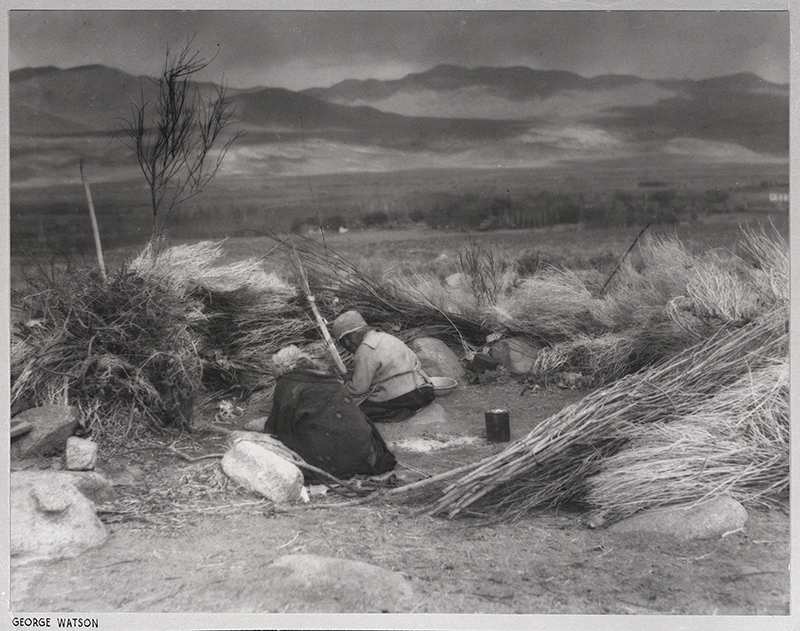|
|


Click image to enlarge
"Inyo Desert — Two Indians huddle around a campfire to escape cold wind." Unfortunately that description, written by the photographer, George Watson, is all we know about this photograph, made in the 1930s and displayed at the L.A. Press Photographers Exhibit in 1939. (Well, we also know he shot it with a 4x5 Speed Graphic camera on 4x5 film using natural light.) The original 4x5-inch negative went to the Getty. This is an early 4x5-inch copy negative from the Watson Archive. Basketry might provide a locational clue within Inyo County, but we're not seeing basketry in this photograph. Instead the people are using a Western bowl, frying pan and some sort of metal canister. They are wearing Western clothing (including hat). They have traditional grinding stones (far left) and a brush windbreak, but there are no cultural materials that would tell us whether they're Newe (Shoshone) from Death Valley or Nüümü (Paiutes) from Owens Valley or Saline Valley or Round Valley/Bishop. The mountains, likely the easternmost Sierra Nevadas, would suggest Owens Valley or perhaps the more southerly Coso Range. The view is likely to the west. If it's Owens Valley, it might explain the news rationale for this photograph. In the 1930s, the City of Los Angeles was still pursuing its goal of "removing" the last native inhabitants of the land it purchased for its Los Angeles Aqueduct. It sought to convince people to move to the tiny reservation that had been established in 1915 at Fort Independence, just north of the town of Independence. Background: The native inhabitants of the Owens Valley had been unaffected by the Spanish and Mexican periods in California — the colonists never got that far inland — and most never saw a white person before the first American settlers arrived in the 1850s. In 1852, troops under the command of the U.S. Indian agent, Gen. Edward F. Beale, rounded up a lot of Owens Valley Paiutes and took them on a 200-mile march to the Sebastian Indian Reservation at the southern edge of the San Joaquin Valley near Fort Tejon. But many escaped along the way and returned to their ancestral homes. Still others probably went home when the government abandoned the Sebastian Reservation after only a few years — rather than move again to yet another unfamiliar place, this time the Tule River Reservation. (The people who actually lived in the Tejon area were culturally and linguistically different from the Owens Valley Paiutes. They were Southern Valley Yokuts, Kitanemuk, and some Chumash people who escaped from the Santa Barbara Mission in 1824. Tule River was Yokuts territory.) The partial removal of the Indians from the Payahüünadü — the place of flowing water (Owens Valley) — cleared the way for American farmers and ranchers to prove up homesteads there. The native inhabitants were allowed — by law, and usually in practice — to live on the land. Many of the men who survived the new American diseases found employment as ranch hands. So, when Los Angeles city officials started buying up land and water rights from Owens Valley farmers in the first decade of the 20th Century, many Paiutes were still living there and using the water. Perhaps the people in this photograph are two of the last native people living on L.A. City property in Inyo County. We don't know. Today, in the 21st Century, the Bishop Paiute Tribe, whose members include descendants of the first residents of the Owens Valley, continues to deal with the City of Los Angeles in pursuit of habitat restoration, access to ancestral lands and sacred sites, and use of the water that had sustained the people for thousands of years.
LW3043: 9600 dpi jpeg from 4x5 negative purchased 2017 by Leon Worden.
|
Friends of Eastern Calif. Museum Newsletter
Swansea Petroglyphs (60)
Bedrock Mortars, Independence (11)
Inyo County: 2 Indians Huddle for Warmth, 1930s
L.A. Aqueduct Construction Equipment (28)
Lake Views, Relics at Keeler (40)
From Yellow Grade Road (3)
|
The site owner makes no assertions as to ownership of any original copyrights to digitized images. However, these images are intended for Personal or Research use only. Any other kind of use, including but not limited to commercial or scholarly publication in any medium or format, public exhibition, or use online or in a web site, may be subject to additional restrictions including but not limited to the copyrights held by parties other than the site owner. USERS ARE SOLELY RESPONSIBLE for determining the existence of such rights and for obtaining any permissions and/or paying associated fees necessary for the proposed use.





